How Austria Reappeared on the Map of Europe
by Dr. Walter R. Roberts
NB: This account is of special interest in that the author was a member of the US delegation at the 1955 four power negotiations which restored Austrian sovereignty. Ed.
In an article published in “American Diplomacy” in February 2012, the author described the developments that led to the disappearance of Austria from the map as a result of its annexation by Nazi Germany on March 11, 1938. On that day, Austria ceased to exist. Austrian citizens became German citizens and the Austrian state became German territory.
I.No Austrian government in exile emerged. Moreover, no government would have recognized an Austrian government in exile. For all countries, with the exception of Mexico, the annexation was a fait accompli. The American Legation in Vienna became an American Consulate reporting to the American Embassy in Berlin.
However, there was one person who supported Austrian independence with vigor and enthusiasm: Otto von Habsburg, the oldest son of the last Austrian Emperor Karl I who had gone with his family into exile after Austria declared itself a republic in 1918.
At the time of Austria’s annexation in 1938, Otto lived in France and was very active on behalf of Austrian independence. During the dramatic days prior to the annexation, when Austrian Chancellor Kurt Schuschnigg battled for Austrian independence, Otto proposed to Schuschnigg that he come to Austria and take over the government. Otto was then 26 years old. He made the offer fully aware that the “Habsburg Act,” adopted by the new Austrian Republic in early 1919, banned all members of the Habsburg family from entering Austria.
After Austria’s annexation by Germany, Otto’s army of one fought to keep Austria’s name alive. A French broadcasting station carried a program supported, (as rumor had it) by Otto, constantly repeating “Oesterreich wird wieder frei” (Austria will be free again). The program went off the air when Germany occupied France in 1940. Otto and his family fled to the United States on visas authorized by President Roosevelt. He settled in Washington and over the next four years had frequent meetings with Roosevelt in which the status of Austria, then and in the future, was discussed. These meetings began when the United States was still a non-belligerent and Otto was 28 years old.
Roosevelt took a remarkable interest in European royalty. In my book “Tito, Mihailovic and the Allies, 1941-1945” I refer to Roosevelt’s relationship with 21 year old King Peter II of Yugoslavia. In a note to Secretary of State Cordell Hull in 1944, Roosevelt asked the secretary to draft a letter to King Peter with the salutation “ ‘Dear Peter’ as I have always treated him as a sort of ward.”
.
What influence, if any, Otto had on Roosevelt’s thinking about Austria is debatable. There were two incidents in which Roosevelt accepted Otto’s recommendations. The first concerned the creation of an Austrian battalion within the U.S. Army. Otto believed that such a battalion would indicate a close American-Austrian relationship and be proof that Austria was fighting on the Allied side. The enterprise collapsed even before it started. The majority of Austrians who joined the US Army in the 1940’s were Jews who wanted to fight for the United States, become American citizens and start a new life in America. They wished to forget their Austrian past and the Nazi laws that cruelly changed their lives.
Otto was more successful in 1943 when the U.S. issued postage stamps honoring the exiled governments that represented the oppressed countries of Europe. At first, Austria was not included in the series because no Austrian government in exile existed. But after Otto’s plea, and in light of the decisions regarding Austria at the Tripartite Moscow Conference of October 1943, Austria was added to the series with this stamp. I am indebted to my colleague and friend George Jacobs for providing this stamp and others included in this article as well as for information regarding their use.
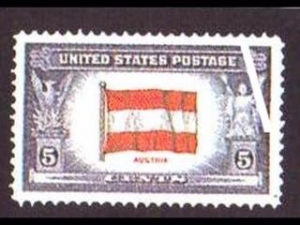
II.
The war which started in September 1939 when Germany attacked Poland and which widened when Germany invaded the Soviet Union in June of 1941 became a world war after Japan attacked the United States in December 1941. In these years, considering the overall military situation, the future of Austria was not on the agenda of foreign offices. This started to change when the Allies began to register battlefield victories. We know, for instance, that President Roosevelt shared some thoughts on Austria with Archbishop Francis Spellman of New York in early September 1943. Asked by the Archbishop whether Austria would eventually fall under some sort of Russian protectorate, the President answered affirmatively. He added that an Austrian exile government would neither be established nor tolerated. The only way Austria could escape outright Russian domination would be if Otto von Habsburg could reclaim the throne of Austria and Hungary, but even then he would have to work out some accommodation with the Russians. (I am indebted for this information to Gerald Stourzh who reports on the FDR-Spellman meeting in his excellent book “Geschichte des Oesterreichischen Staatsvertrages”).
At that time, it appeared that Roosevelt did not want the United States to engage in the reconstruction of Europe after a victory over Germany and, as we will see, he was not willing to have US troops involved in the occupation of Austria. (He grudgingly changed his mind later). During British foreign secretary Anthony Eden’s first visit to Moscow after Germany had attacked the Soviet Union, and nine days after Pearl Harbor, Eden was told by Joseph Stalin that Austria should be an independent country after the war. .
The British Foreign Office was the first to think seriously about the future of Austria. In the spring of 1943, it drafted a statement designed, among other things, to encourage Austrian resistance to the German war effort. The British draft declared the union imposed on Austria by Germany in March 1938 “as null and void” and expressed the wish “to see re-established a free and independent Austria.” The British statement referring to the participation in the war on Germany’s side, also mentioned Austrians’ responsibility “which they cannot evade” and that in the final settlement “account will inevitably be taken of the part they play in assisting to expel the German invader.” It also referred to the possibility that Austria may associate itself with neighboring states that will encounter post-war problems, particularly in the economic area.
The British War Cabinet unanimously endorsed the statement. It was forwarded to the State Department in Washington where it won approval with some minor changes. It was also sent to Moscow.
The statement was drafted for psychological warfare purposes and was to be issued immediately; however it was not because discussions were underway regarding a possible Heads of State conference or a Tripartite Conference at the foreign ministers level. The arrangement of a Heads of State conference encountered difficulties but a decision was made for the foreign ministers of Great Britain, the United States and the Soviet Union to meet in Moscow. The British draft, endorsed by the United States, became an important document of the Tripartite Conference in Moscow, which took place from the 18th of October until November 1, 1943.
III.
The Moscow Conference of Secretary of State Cordell Hull, Foreign Secretary Anthony Eden and Foreign Minister Vyacheslav Molotov was an important event in the history of Austria’s re-emergence. For the first time since 1938, Austria was discussed at an international conference and decisions were reached regarding its future. The text of the Moscow declaration on Austria was finalized in several meetings of representatives of the three powers and was published on November 1, 1943.
The final version was based on the original British draft but contained a couple of important changes. The suggestion that Austria, after the war, would associate itself with other central and east European countries was dropped. The US was not very enthusiastic about such a solution and the Soviets firmly opposed it. The clause regarding the responsibility of the Austrians for participating in the war on the side of Germany was considerably strengthened at the insistence of the Soviet delegation.
Two weeks later, on November 16, 1943, the French Committee of National Liberation, headed by General Charles de Gaulle, endorsed the Moscow Declaration on Austria.
Another important decision of the Moscow Conference was the creation of the European Advisory Commission (EAC) to study the political problems following Germany’s defeat, including the surrender terms and the machinery required for administering Germany. With the decision to create an independent Austria, the work of the proposed commission was expanded.
A personal anecdote: in 1943, I was a writer serving in the German section of the Voice of America. There were no broadcasts specifically aimed at reaching the Austrian people. However, in the aftermath of the Moscow Declaration on Austria, an Austrian unit was created within the German section that prepared broadcasts designed for Austrian listeners.
IV.
The Moscow Declaration on Austria immediately affected the overall war plan. Prior to the Moscow Conference the aim was singular: the defeat of Germany. Now attention also focused on whether allied troops would enter Austria from Germany or from Italy and whether Austrians would be treated like Germans as defeated enemies or somewhat differently.At the Heads of State conference in Tehran which followed the Moscow Conference by only a few weeks (November 28-Decmber 1, 1943) British Prime Minister Winston Churchill raised the possibility that Austria could be invaded from the Italian front.
In May 1944, British General Sir Henry Maitland Wilson, the Allied Commander in the Mediterranean, requested authorization to plan for the occupation of southeastern Europe, including Austria. The British Chiefs of staff gave their consent immediately but the American Chiefs had a problem.
After his return from Tehran, President Roosevelt sent a memorandum to Secretary of State Cordell Hull (February 21, 1944) in which he said: “I do not want the United States to have the post-war burden of reconstituting France, Italy and the Balkans” which was followed on April 30 by another memorandum that stated: “This government is of the opinion that the southern zone and Austria should be occupied by British Forces.” (Quotations from Foreign Relations of the United States – FRUS). These memoranda coincided with General Wilson’s intentions, who reported at the end of July that, with the approval of General Dwight D. Eisenhower, the Supreme Allied Commander, he was planning to occupy Austria with four British divisions . He made this statement despite the westward drive of the Soviet forces which indeed reached Austria before the British. President Roosevelt changed his mind slightly so that the American representative at the European Advisory Commission, Ambassador John G. Winant, was able to say that the United States agreed to participate in the eventual occupation of Austria “without committing the US respecting the size of the contingent that we might be willing to contribute for this occupation” (Quotation from FRUS).
V.
At the end of March, 1945, two Soviet armies – one headed by Marshal Fedor Tolbukhin and the other by Marshal Rodion Malinowski – were poised at the Austrian-Hungarian border to cross into Austria. They had occupied Hungary and were ready for one of the final battles of World War II. Two events – one in Moscow and the other in Austria – took place almost simultaneously at the end of March and early April, and had a profound impact on Austria’s future.
I owe the description of the Moscow event to Jim Critchlow and Mark Kramer who directed me to General S..M.Shtemenko’s “The Soviet General Staff at War.” Shtemenko describes a meeting with Joseph Stalin, at the end of March 1945, in which Austria was discussed and quotes Stalin as follows: “By the way, where is that Social Democrat Karl Renner who was Kautsky’s disciple? He was for many years among the leaders of the Austrian Social Democrats and, as far as I remember, headed the last Austrian parliament. We must not neglect influential forces with anti-fascist views…”
The general staff immediately asked Marshal Tolbukhin, whose army had penetrated Austrian soil (but had not yet reached Vienna), to determine whether Renner was still alive and if so to find him.
Dr. Karl Renner was indeed alive and lived in retirement in Gloggnitz (located between the Hungarian border and Vienna) which became occupied by Tolbukhin’s army on April 1. Stalin was right: Renner was the last president of the Austrian parliament in the 1930’s. The 75year old Renner decided on April 3 to go to the closest Red Army post to offer his services to the occupying power. He was accompanied by a Czech guest worker. Renner asked him to come along because he thought that a Czech speaking person might make it easier for him to communicate with the Russians.
When Renner came to the first Russian command post, the request from headquarters to find Renner had arrived and he was greeted with respect and sent to Tolbukhin’s headquarters which was then still outside Vienna. Negotiations took place between Renner and senior Russian officers and officials, including Marshal Tolbukhin. Renner wrote a deferential letter to Stalin and also established contact with old colleagues in the Social Democratic party (soon to be known as the Socialist party) and with representatives of the pre-war Christian-Social Party (soon to be known as Volkspartei). He also contacted members of the Austrian communist party, which never had enough popular support to have representation in the pre-war Austrian parliament but had to be taken into account because of the presence of the Soviet army. As he tried to form a provisional government, Renner obtained agreement that all ministries were to be headed by three officials – one secretary and two undersecretaries, with each party represented by either a secretary or an undersecretary.
Vienna was fully in Soviet hands by April 13 with Tolbukhin’s headquarters established there. On April 20, Tolbukhin received an order from Moscow for Renner to form a government. Renner, however, did not wish to be appointed by Moscow, so he assembled all reachable members of the last Austrian parliament of 1934 who, in turn, unanimously appointed him chancellor. On April 27, Renner presented his cabinet to Tolbukhin who gave a lavish lunch in their honor.
It was thus on April 27,1945, that a truncated Austria reappeared on the map. The Austrian government was recognized by the Russians; however, the Western allies refused recognition because they regarded the government as a Soviet satellite. Moreover, the power of that government was limited to the Soviet occupation zone whose exact boundaries had still not been determined by the European Advisory Commission.
On April 27, the only foreign troops on Austrian soil were the Russians. It was on the next day that the first Americans crossed into Austria in Tirol. On April 29, the first French troops crossed into Vorarlberg and not until May 7 did the British forces reach Carinthia. There was confusion among the occupying powers as to where their respective zones began and ended. It took two months after the end of the war for the EAC (on July 4) to agree on the exact boundaries of each occupation zone and not until July 9 was an occupation plan for the city of Vienna announced.
The following four stamps illustrate the confusion that reigned in Austria at the time. With the exchange rate between the German Mark and the new Austrian Schilling set at 1:1, the Soviet authorities released the old German stamps showing Hitler’s face with overprint “Oesterreich”. These stamps were valid only in the Soviet zone.
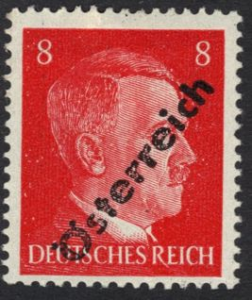
For the other three zones (U.S., U.K. and French) a stamp printed in the US displaying the word “Oesterreich” was released.
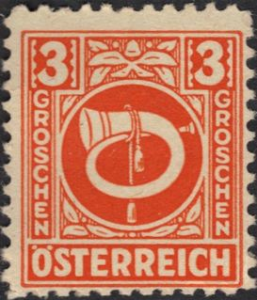
The third stamp was issued in the Soviet zone in June 1945. This time all old German stamps with the overprint “Oesterreich” were replaced by stamps blocking out Hitler’s head and the words “Deutsches Reich”.
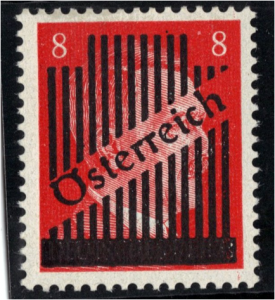
July 4, once the borders of the four occupation zones were clearly delineated, yet another stamp was issued in the Soviet zone. That stamp, in various denominations, was a facsimile of the last Austrian stamp of 1938 displaying the words “Republik Oesterreich” was the only stamp then valid in the Soviet zone.
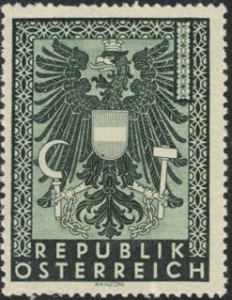
VI.
Meanwhile, the occupying powers were engaged in establishing the administration of their zones. Military and civilian officers were recruited for military government duties. In the case of the United States, the recruiting process started in London as early as 1943. Even before the Moscow Declaration on Austria, SHAEF (Supreme Headquarters Allied Expeditionary Force), designated a few officers for occupation duty in Austria, but the emphasis was selecting officers for occupation assignment in Germany. After the Moscow Declaration, more attention was given to the Austrian group. General Lester Flory was appointed to head it. On January 30,1945, the group was formally established in London as a nucleus planning staff for the future U.S. military government in Austria, It was called the U.S.Group, Control Council (Austria) (from FRUS). U.S.G.C.C. was moved to Caserta, Italy (seat of AFHQ – Allied Forces Headquarters) at the beginning of April 1945 where it should have moved earlier because Caserta, rather than London, had responsibility for the occupation of Austria.
The Flory group found a military situation very different from the one anticipated only a year earlier. The Russians were battling in Austria, while the other allies did not reach Austria until the end of April and early May. There was no way for the Flory mission (and for that matter similar British and French missions) to reach Vienna except through negotiations with the Russians. The latter were intent on delaying the American, British and French forces from coming to Vienna citing the absence of a zone agreement as their principal reason. Finally, an understanding was reached with the Russians for the Western allies to come to Vienna, but only for a short visit (June 2-13).
The American group under General Flory, the British group under General John Winterton and the French group under General Paul Cherrier assembled in Klagenfurt (in the British occupation zone). It was a small group of 186 people. They drove toward the temporary American-Russian occupation zone border where they were cordially received by the Russians and escorted to Vienna. Finally, Americans, British and French could be seen in Vienna when they drove through the city with their respective flags flying.. The Russians were helpful in finding future quarters for the Western allies. However, there was a problem regarding airfields. The Russians were unwilling to allocate airfields within the confines of Vienna to the Western powers, which resulted in the U.S. airfield to be located in Tulln, 20 miles from Vienna.
Once the occupation zones were clearly drawn by the European Advisory Commission, appointments were made: General Mark Clark was designated Commander of the American Zone,. General Sir Richard McCreery, Commander of the British zone and General Emile Bethouart, Commander of the French zone. These three generals, as well as Marshal Ivan Konev (who had replaced Marshal Tolbukhin), were the constituent members of the Allied Council, which was to administer Austria until the conclusion of an Austrian Treaty. Only then would Austria’s sovereignty be completely restored.
The Army commanders were also designated as High Commissioners, which meant that they were both the military and civil representatives of their country.
The Allied Council met for the first time in Vienna on September 11, 1945. In attendance were generals Clark (US), McCreery (UK), Bethouart (France) and Marshal Konev (USSR). After that session, the Council issued a proclamation in which it declared that it was exercising the role of supreme power in Austria. The Austrian government under Chancellor Renner was not mentioned in the proclamation. In the session of October 1, the Allied Council recommended that the four occupying powers recognize the Renner government and its authority over all of Austria. Britain, France, the United States and the Soviet Union agreed on October 20.
Austria now had a government that was recognized by the occupying powers, but the Allied Council was the supreme authority. It was a benign authority. The German control agreement required the assent of all four occupying powers to German laws; in Austria the reverse veto was adopted. Austrian laws duly adopted became law unless all four occupying powers objected (which never occurred).
After the Austrian elections on November 25, 1945, Leopold Figl, the leader of the Volkspartei, replaced Renner of the Socialist party as Chancellor and Renner was elected by parliament to be President of Austria.
The stamps issued by the new Austrian government showed in bold type “Republik Oesterreich” and depicted Austrian scenes; the one printed here shows the Gloriette in Schoenbrunn Castle Gardens. They replaced all the stamps circulating in the four occupation zone and were valid throughout Austria.

On the occasion of Renner’s election as President of Austria, the Austrian government issued a stamp with Renner’s picture.
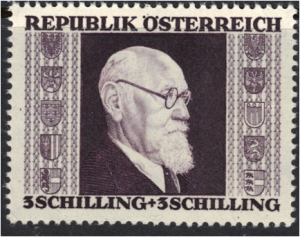
Austria established diplomatic relations with many countries, including the United States. U.S.Minister John Erhardt presented his credentials to President Renner on September 7, 1946 and Austrian Minister Dr. Ludwig Kleinwaechter presented his credentials to President Truman on December 4, 1946. Not until almost 10 years later, when the Austrian Treaty was signed, did the supreme authority revert to Austria. Long negotiations by the representatives of the US, USSR, UK and France ran into repeated “nyets” from the Soviets. But suddenly, in 1955, the Russians reversed their stand.
There are several theories as to why the Soviet position changed. Certainly, the policy of Nikita Khrushchev, the new Soviet leader, of improving his country’s relations with the United States played a pivotal role.
During my assignment at the American Embassy in Belgrade, I learned of a meeting between the Soviet and Yugoslav communist parties in Moscow in December 1954. At a dinner, Khrushchev asked the Yugoslav delegation to give him advice on how to improve relations with the United States. After all, he added, Yugoslavia had not done badly in improving its relations with Washington. A member of the Yugoslav delegation suggested that the Soviets agree to an Austrian treaty. According to a participant, Khrushchev appeared to be intrigued by the idea and asked his advisors: “why not”?
This occurred at a time when representatives of the U.S., Britain, France and Austria were actively engaged diplomatically in persuading the Soviet government to resume Austrian treaty negotiations. In these exchanges, the concept of permanent neutrality of Austria was discussed, an idea that was raised as early as 1952 by a member of the Soviet embassy in Washington with an Austrian diplomat.
On February 8, 1955, Foreign Minister Vyacheslav Molotov gave a speech in which he said that the Soviet government considered a continued delay in concluding an Austrian treaty unjustified.
Four power negotiations resumed early in May in Vienna. I was present as a member of the American delegation.
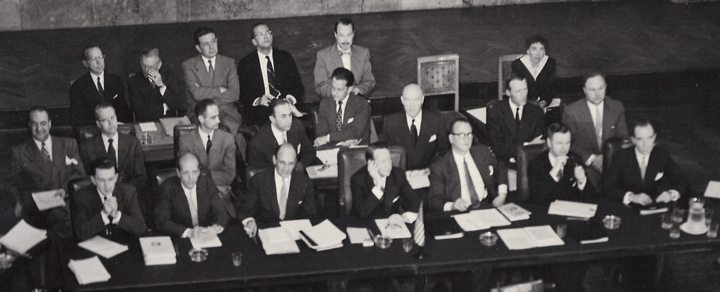
The negotiations were conducted in a business-like atmosphere. An Austrian Treaty was concluded and signed in Vienna on May 15, 1955 by the foreign ministers of the four occupying powers, the four High Commissioners and the foreign minister of Austria: John Foster Dulles (US), Harold Macmillan (UK). Antoine Pinay (France), Vyacheslav Molotov (USSR) as well as Llewellyn E.Thompson (US),Geoffrey A. Wallinger (UK), Ivan Ilitchov (USSR),Roger Lalouette (France) and Leopold Figl (Austria).
The Austrian government issued a stamp with the overprint “Staatsvertrag. 1955” on that occasion.
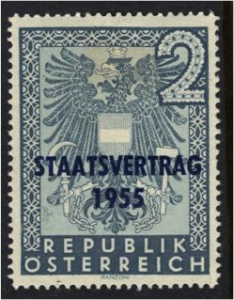
On October 25, 1955 the last foreign soldiers left Austrian territory. On December 14, 1955, Austria became a member of the United Nations.
After 17 years, Austria was truly on the map again.![]()
(I am greatly indebted to my friend Hugo Portisch for his monumental work, “Oesterreich I”).
American Diplomacy is the Publication of Origin for this work. Permission to republish is freely granted with credit and a link back to American Diplomacy.
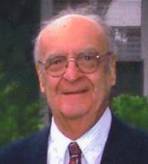
Dr. Walter R. Roberts started his government career with the Voice of America. He retired from the government after serving as Associate Director of the U.S. Information Agency. President George H. W. Bush appointed and President Bill Clinton reappointed him as member of the U.S. Advisory Commission on Public Diplomacy. He is the author of Tito, Mihailovic and the Allies, 1941-1945 and numerous articles on foreign policy.
